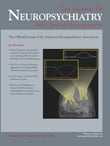Sleepwalking in Multiple Sclerosis: A Case Report
To the Editors: Multiple sclerosis is an inflammatory demyelinating disease in which patches of damage called plaques or lesions predominantly appear in the cerebral white matter. Multiple sclerosis is frequently associated with psychiatric manifestations (e.g., patients with multiple sclerosis have more sleep disorders than the general population). 1 , 2 However, there has been no literature regarding somnambulism related to multiple sclerosis.
Case Report
A 33-year-old man with diagnoses of multiple sclerosis and anxiety disorder has been followed for 2 years. He was treated with interferon beta-1a, 22 mcg three times per week; venlafaxine, 225 mg/day; and tioridazin, 20 mg/day. He began to complain about sleepwalking during the first one-third of the night. The dosage of venlafaxine was decreased to 150 mg/day, and imipramine, 50 mg/day, was initiated. He complained of ataxic walking, increasing of ataxia, dizziness, imbalance, and fatigue. He had no epileptic seizure. On MRI, demyelinating plaques lining to corpus with vertical angle were seen in bilateral periventricular white matter, but they were also retained in the corpus callosum and left brachium pontis. There were increases of a few multiple millimetric signals at the level of pericallosal and semiovale, especially on the left and posterior side on T 2 -weighted imaging. There were a few millimetric signal increases in the pons in favor of demyelinating plaques.
Discussion
Sleepwalking is one of the most common parasomnias, and genetic, developmental, organic, and psychological factors have been proposed as causes. Sleepwalking episodes can be triggered by fever, medication with some drugs, stress, and major life events. 3 Neither sleepwalking in our patient’s family history or in his childhood period, nor epileptic history or fever, were detected in the present case.
During non-REM sleep, PET studies have shown a net reduction in cerebral activity in the thalamic nuclei, brain stem (mesencephalon and tegmentum of pons), basal ganglia, hypothalamus, basal forebrain, the orbitofrontal and anterior cingulate cortical regions, the precuneus, and the right mediotemporal regions. 4 There were a few millimetric signal increases in the pons giving evidence for demyelinating plaques. It has been reported that the unilateral small lesion of the pontine tegmentum could be responsible for the parasomnia overlap disorder as in other rare lesional cases. 5 We considered such overlapping in our patient because demyelinating plaques lining to corpus with a vertical angle were seen in bilateral periventricular white matter, but they were retained in the corpus callosum and left brachium pons in imaging.
Paroxetine and lithium may have triggered the episodes of somnambulism. 3 Until now, there have been no reports relating venlafaxine to somnambulism. Although the patient had been using venlafaxine for 2 years without parasomnia complaint, decreasing the dosage of venlafaxine did not affect the frequency of sleepwalking. Thus, we suggested that demyelinating plaque in the pons might be responsible for the sleepwalking as a neuropsychiatric symptom in multiple sclerosis.
1. Diaz-Olavarriaeta C, Cummings JL, Velazquez J, et al: Neuropsychiatric manifestations of multiple sclerosis. J Neuropsychiatry Clin Neurosci 1999; 11:51–57Google Scholar
2. Merlino G, Fratticci L, Lenchig C, et al: Prevalence of “poor sleep” among patients with multiple sclerosis: an independent predictor of mental and physical status. Sleep Med 2009; 10:26–34Google Scholar
3. Juszcak GR, Swiergiel AH: Serotonergic hypothesis of sleepwalking. Med Hypotheses 2005; 64:28–32Google Scholar
4. Dauvilliers Y: The major physiological functions during sleep, in Sleep: Physiology, Investigations, and Medicine. Edited by Billiard M. New York, Kluwer Academic/Plenum Publishers, 2003, pp 45–61Google Scholar
5. Limousin N, Dehais C, Gout O, et al: A brainstem inflammatory lesion causing REM sleep behavior disorder and sleepwalking (parasomnia overlap disorder). Sleep Med 2009; 10:1059–1062Google Scholar



